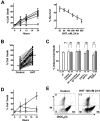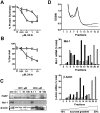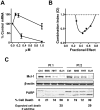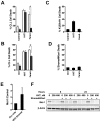Homoharringtonine reduced Mcl-1 expression and induced apoptosis in chronic lymphocytic leukemia
- PMID: 20971952
- PMCID: PMC3037741
- DOI: 10.1182/blood-2010-01-262808
Homoharringtonine reduced Mcl-1 expression and induced apoptosis in chronic lymphocytic leukemia
Abstract
Homoharringtonine (HHT) is a plant alkaloid that inhibits the elongation phase of translation that is currently in clinical trials. Because the intrinsically short-lived antiapoptotic protein myeloid cell leukemia-1 (Mcl-1) has been reported to support the survival of chronic lymphocytic leukemia (CLL) cells, we hypothesized that inhibition of protein synthesis by HHT would decrease Mcl-1 expression and induce apoptosis in CLL. In primary CLL cells, HHT induced significant apoptosis independent of the prognostic characteristics of the patients. This was associated with inhibition of translation and decreased Mcl-1 levels in CLL cells. Mcl-1 reduction was evident as early as 2 hours and continued to decrease in the next 6-8 hours, whereas cell death started in 2 hours and continued to increase for 24 hours. Reduction of the Mcl-1 level was due to translation inhibition and proteasome degradation rather than to transcription inhibition or caspase cleavage. HHT and the transcription inhibitor SNS-032 induced synergistic cell killing. Although stromal cells induced Mcl-1 expression and protected CLL cells from the toxicity of fludarabine, this induction was reversed by HHT, which overcame stromal cell-mediated protection. Thus, these results provide a rationale for clinical development of HHT in CLL as single agent or in combinations.
Figures






Similar articles
-
Mechanism of action of SNS-032, a novel cyclin-dependent kinase inhibitor, in chronic lymphocytic leukemia.Blood. 2009 May 7;113(19):4637-45. doi: 10.1182/blood-2008-12-190256. Epub 2009 Feb 20. Blood. 2009. PMID: 19234140 Free PMC article.
-
Semisynthetic homoharringtonine induces apoptosis via inhibition of protein synthesis and triggers rapid myeloid cell leukemia-1 down-regulation in myeloid leukemia cells.Mol Cancer Ther. 2006 Mar;5(3):723-31. doi: 10.1158/1535-7163.MCT-05-0164. Mol Cancer Ther. 2006. PMID: 16546987
-
AT-101 induces apoptosis in CLL B cells and overcomes stromal cell-mediated Mcl-1 induction and drug resistance.Blood. 2009 Jan 1;113(1):149-53. doi: 10.1182/blood-2008-02-138560. Epub 2008 Oct 3. Blood. 2009. PMID: 18836097 Free PMC article.
-
Homoharringtonine in the treatment of acute myeloid leukemia: A review.Medicine (Baltimore). 2024 Nov 1;103(44):e40380. doi: 10.1097/MD.0000000000040380. Medicine (Baltimore). 2024. PMID: 39496012 Free PMC article. Review.
-
Inflammation and survival pathways: chronic lymphocytic leukemia as a model system.Biochem Pharmacol. 2010 Dec 15;80(12):1936-45. doi: 10.1016/j.bcp.2010.07.039. Epub 2010 Aug 7. Biochem Pharmacol. 2010. PMID: 20696142 Free PMC article. Review.
Cited by
-
Homoharringtonine inhibits the NOTCH/MYC pathway and exhibits antitumor effects in T-cell acute lymphoblastic leukemia.Blood. 2024 Sep 19;144(12):1343-1347. doi: 10.1182/blood.2023023400. Blood. 2024. PMID: 38968151 Free PMC article.
-
Regulation of Mcl-1 expression in context to bone marrow stromal microenvironment in chronic lymphocytic leukemia.Neoplasia. 2014 Dec;16(12):1036-46. doi: 10.1016/j.neo.2014.10.002. Neoplasia. 2014. PMID: 25499217 Free PMC article.
-
Homoharringtonine interacts synergistically with bortezomib in NHL cells through MCL-1 and NOXA-dependent mechanisms.BMC Cancer. 2018 Nov 16;18(1):1129. doi: 10.1186/s12885-018-5018-x. BMC Cancer. 2018. PMID: 30445933 Free PMC article.
-
The translational repressor 4E-BP1 regulates RRM2 levels and functions as a tumor suppressor in Ewing sarcoma tumors.Oncogene. 2021 Jan;40(3):564-577. doi: 10.1038/s41388-020-01552-0. Epub 2020 Nov 15. Oncogene. 2021. PMID: 33191406 Free PMC article.
-
Antiproliferative Activity of Cephalotaxus Esters: Overcoming Chemoresistance.Comb Chem High Throughput Screen. 2025;28(7):1264-1275. doi: 10.2174/0113862073322175240823104921. Comb Chem High Throughput Screen. 2025. PMID: 39444179
References
-
- Robertson LE, Plunkett W, McConnell K, Keating MJ, McDonnell TJ. Bcl-2 expression in chronic lymphocytic leukemia and its correlation with the induction of apoptosis and clinical outcome. Leukemia. 1996;10(3):456–459. - PubMed
-
- Pepper C, Lin TT, Pratt G, et al. Mcl-1 expression has in vitro and in vivo significance in chronic lymphocytic leukemia and is associated with other poor prognostic markers. Blood. 2008;112(9):3807–3817. - PubMed
-
- Longo PG, Laurenti L, Gobessi S, et al. The Akt/Mcl-1 pathway plays a prominent role in mediating antiapoptotic signals downstream of the B-cell receptor in chronic lymphocytic leukemia B cells. Blood. 2008;111(2):846–855. - PubMed
Publication types
MeSH terms
Substances
Grants and funding
LinkOut - more resources
Full Text Sources
Medical
Research Materials

